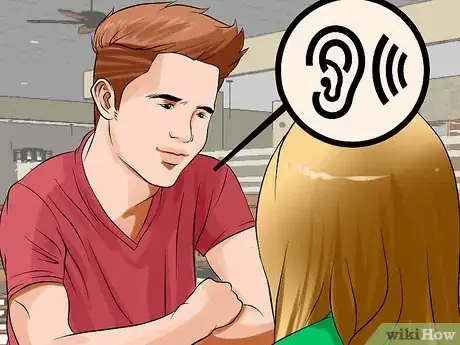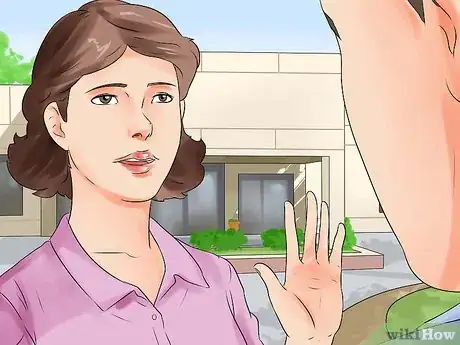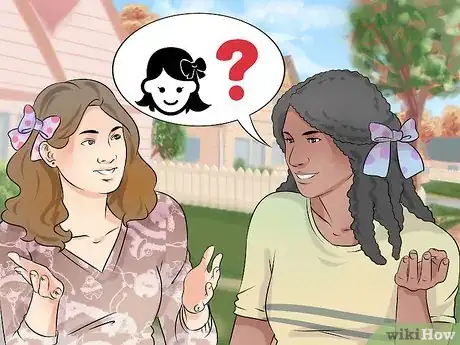This article was co-authored by Cristina Morara. Cristina Morara is a Professional Matchmaker, Dating Coach, Relationship Expert, and the Founder of Stellar Hitch Private Matchmaking, a luxury matchmaking service based in Los Angeles that serves clients nationwide and internationally. As a former casting director, Cristina specializes in finding the perfect partner through her exclusive global network and detailed, warm approach. Cristina holds a BA in Communications and Psychology from Villanova University. Stellar Hitch has been featured in the Huffington Post, Chelsea Handler’s Netflix documentary, ABC News, the Tonight Show, Voyage LA, and the Celebrity Perspective.
There are 12 references cited in this article, which can be found at the bottom of the page.
This article has been viewed 310,737 times.
There are many challenges and pitfalls of communication or conversation with others. Sometimes the most difficult part about conversations is knowing how to join in on one. Networking events, social events, and parties usually involve groups of people having separate small conversations and a component of mingling with others. If you hear a conversation that sounds interesting and want to join in, you'll have to know how to observe, join the conversation, and keep the conversation going.
Steps
Observing First
-
1Sense the openness of the conversation. Take the time to observe if the conversation is open or closed, by looking at the body language of the people involved. If it seems to be a serious conversation, or a closed conversation, they may not prefer to have anyone join them. [1] If the group seems more open, take the opening as a sign that it's okay to move forward with joining the conversation.
- In an open conversation, you may notice open arms, speaking in louder voices, and a larger or more open circle.
- In a closed conversation, you may notice closed or folded arms, speaking in low voices, and being physically closer to one another in a tighter circle.
-
2Naturally position yourself. As you move a little closer to joining the conversation, try and have a reason to be close to the group that would allow you to naturally overhear them. Without a natural reason to be closer to the group, your presence may been perceived as eavesdropping, lurking, or creepy. Some natural ways to get closer to the group include:
- Refilling a drink
- Getting some food
- Waiting in a line
- Studying movies or books on a shelf or art or posters on the walls.
Advertisement -
3Listen. Before jumping in take some time to listen to what they are talking about. Listen for what kind of conversation it is and the topic of conversation before jumping in.[2] This way you will be well prepared to know when it is appropriate to give your opinion or ask a question.[3]
- Is it a more serious or somber conversation? Is the topic of a personal nature?
- Is it a more comical or topical conversation? Is the topic more of a causal nature?
- How interested are you in the conversation?
-
4Check in with yourself. The biggest conversation-killer is self-consciousness. Your anxiety and comfort level will have a great deal of impact on how easily you join a conversation.[4] If you are nervous, intimidated, or shy, try taking a couple of deep breaths. [5] Know how you are feeling so you can be ready to seize a fitting opportunity when it comes your way.
Joining the Conversation
-
1Use a person you know. If you know or are acquainted with someone in the group, use them as your way in. You'll feel more comfortable with someone you already know and it is an instant conversation starter. Tap them on the shoulder or give them a quick greeting to let them know you are there. If everyone notices or if it interrupts the group discussion, apologize and introduce yourself.
- “I'm sorry, I didn't mean to interrupt. I know John from work and I had to say hello. I'm Jane, by the way, nice to meet all of you.”
-
2Introduce yourself. If you don't know anyone in the group, you can just introduce yourself. This tactic takes some bravery, but those in the conversation will admire you for your courage. Wait for an opening or a lull in the conversation so you don't interrupt anyone. You can choose to introduce yourself to one person in the group or the whole group.[6]
- “Hi, I'm Jane.”
- ”How are you?”
- “Mind if I join?” or “Mind if I sit here?”
-
3Interject into the conversation. If you have set yourself up to be naturally within earshot of the conversation and have listened for awhile to the topic, you can use that to be able to interject into the conversation with minimal effort. Make sure you are interested and excited about the conversation, it will show. You'll also want to start with a gentle way of entering into the conversation, such as:
- “I'm sorry, I couldn't help but overhear...”
- “Excuse me, were you all talking about...”
- "I was over here, looking at the movie collection, did I hear you mention..."
-
4Start a new topic. Once you introduce yourself, you can further the introduction by asking questions or starting a new topic. Make sure you are following along with the flow of the conversation, try not to jump in and change the topic abruptly.[7] When you are just meeting someone, or a group of people at an event, there are several topics you can cover.[8]
- Ask about the situation: “So how do you guys know the bride and groom?"
- Ask about or compliment the environment: “This place is beautiful! Do you know who picked it for the event?”
- Comment or ask about the group: “You guys seem like you've known each other for a long time.”
- Ask about or comment on an interesting outside topic: “Have you seen that new action movie? What did you think of it?”
- Start a story of your own “The strangest thing happened to me this morning.”
-
5Join in on an activity. Another way into a conversation that is particularly useful for parties or more active events. Look around to see if there are card games, party games, or a pool table being used that you can use to join in. [9] If you are attending and event where there is music or dancing, ask someone to dance.[10] Once you have joined in on the activity it gives you something to talk about to the other participants.
- ”Can I get in on the next game?”
- ”Mind if I join in?”
- ”Do you guys have room for one more?”
Keeping the Conversation Going
-
1Continue in the conversation. Let the conversation continue as if you were already part of it. Just because you joined the conversation doesn't mean you need to dominate it. After joining, go back into listening mode for a little while.[11] This will help you get a sense of the people in the conversation as well as set you up as a respectful person. When ready, it is often best to start with a small comment and judge the reaction before continuing.
- ”That's amazing!”
- ”What, really?!”
- ”I can't believe it, that's crazy!”
-
2Watch the body language. After successfully joining in on a conversation, you'll need to decide on whether or not to stay in the conversation. Reading the body language of the group can be particularly helpful in determining whether your presence there is welcomed by the group.
- Glances. Making eye contact is great conversational practice anyway, so watch their faces and notice how they are looking at one another. If they are glancing at each other with odd or confused facial expressions, it may be time to make a graceful exit.
- Feet position. Take a quick glance at where everyone's toes are pointed. If someone has their feet pointed in your direction, they are open, engaged, and interested if what you have to say.[12]
- Change in body language. Look to see how their body language changes after you enter into the conversation. Are they remaining open, or opening more (e.g.- uncrossing their arms, moving in closer, etc.) or are they closing up (e.g.- crossing arms, leaning away, etc.)?
-
3Ask questions. Until you hit upon a topic that you can comment on or are interested in discussing further, ask questions.[13] If nothing naturally pops up ask standard “getting-to-know-you” questions. Be careful not to stay in small talk too long as it can become tedious for everyone involved. Instead use those questions to search for a more interesting subject to transition to.
- What do you do for work?/What are you studying in school?
- Are you from this area?
- Have you been able to travel this summer?
- Have you seen any interesting movies lately?
-
4Be courteous and polite. Always remember throughout the conversation to stay courteous and polite. If the group is talking about a subject that you are familiar with, then gently put in your input. Be careful not to interrupt or cut someone off to say what you need to say. If the group is talking about something you are unfamiliar with, its a perfect time to ask questions. Make sure you are being respectful and making eye contact with the speaker.[14]
Expert Q&A
-
QuestionIs it rude to join a conversation?
 Cristina MoraraCristina Morara is a Professional Matchmaker, Dating Coach, Relationship Expert, and the Founder of Stellar Hitch Private Matchmaking, a luxury matchmaking service based in Los Angeles that serves clients nationwide and internationally. As a former casting director, Cristina specializes in finding the perfect partner through her exclusive global network and detailed, warm approach. Cristina holds a BA in Communications and Psychology from Villanova University. Stellar Hitch has been featured in the Huffington Post, Chelsea Handler’s Netflix documentary, ABC News, the Tonight Show, Voyage LA, and the Celebrity Perspective.
Cristina MoraraCristina Morara is a Professional Matchmaker, Dating Coach, Relationship Expert, and the Founder of Stellar Hitch Private Matchmaking, a luxury matchmaking service based in Los Angeles that serves clients nationwide and internationally. As a former casting director, Cristina specializes in finding the perfect partner through her exclusive global network and detailed, warm approach. Cristina holds a BA in Communications and Psychology from Villanova University. Stellar Hitch has been featured in the Huffington Post, Chelsea Handler’s Netflix documentary, ABC News, the Tonight Show, Voyage LA, and the Celebrity Perspective.
Dating Coach It depends on the context. If there's a group of strangers quietly enjoying a brunch together, yes, it would be kind of rude to just insert yourself into their space. But if you're at a party or in a more open environment, no, there's nothing wrong with talking to people!
It depends on the context. If there's a group of strangers quietly enjoying a brunch together, yes, it would be kind of rude to just insert yourself into their space. But if you're at a party or in a more open environment, no, there's nothing wrong with talking to people!
References
- ↑ https://www.scienceofpeople.com/body-language-examples/
- ↑ Cristina Morara. Communication Coach. Expert Interview. 29 September 2020.
- ↑ https://raisingchildren.net.au/preschoolers/connecting-communicating/communicating/conversation-skills
- ↑ https://pubmed.ncbi.nlm.nih.gov/7722850/
- ↑ https://www.psychologytoday.com/us/blog/communication-success/202209/5-confident-conversational-skills-for-introverts
- ↑ https://hbr.org/2010/03/breaking-into-a-conversation-g-2/
- ↑ Cristina Morara. Communication Coach. Expert Interview. 29 September 2020.
- ↑ https://positivepsychology.com/social-skills-training/
- ↑ https://raisingchildren.net.au/pre-teens/entertainment-technology/free-time-activities/community-activity
- ↑ https://greatergood.berkeley.edu/article/item/how_music_bonds_us_together
- ↑ https://hbr.org/2010/03/breaking-into-a-conversation-g-2/
- ↑ https://www.scienceofpeople.com/feet-body-language/
- ↑ https://www.psychologytoday.com/intl/blog/talking-apes/201706/better-way-make-new-friends
- ↑ https://psychcentral.com/blog/imperfect/2020/01/the-need-to-please-the-psychology-of-people-pleasing#Why-youre-a-people-pleaser
About This Article
If you want to join a conversation, start by finding a way to get near the group without making it seem like you're eavesdropping. You can do this by refilling your drink, checking out some decor near them, or even just getting in line behind them. From there, you can enter the conversation by introducing yourself or by interjecting with a relevant thought. To do this smoothly and politely, try starting with something like, "Hi, I'm Jane. Mind if I join you?" or "I'm sorry, but I couldn't help overhearing what you were saying, and I have some thoughts." For more tips from our co-author, like how to keep a conversation going, read on!






















-Step-11.webp)


















































